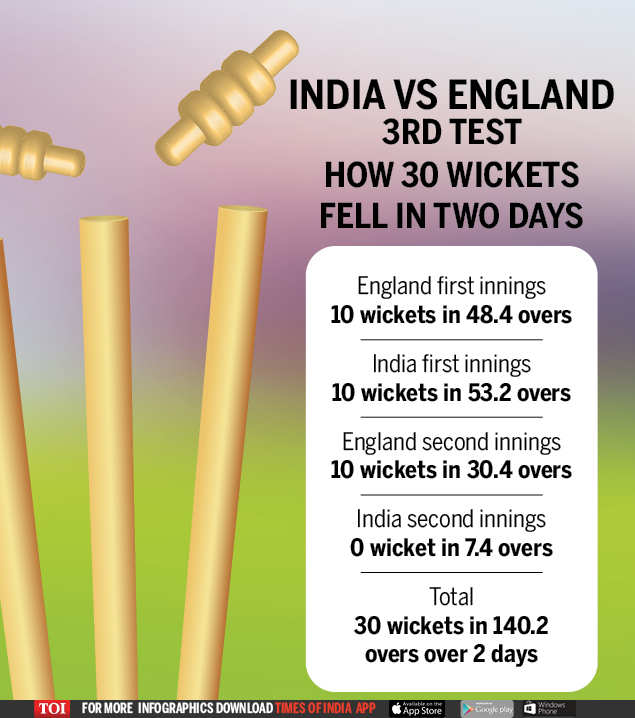India vs England: Pitch conundrum – To play or not to play | Cricket News – Times of India
This isn’t the first time it has happened in India and it isn’t that past cricketers didn’t know how to handle it, or visitors didn’t seek local assistance and experience in handling such pitches.
At a dinner in 1987, during the fifth and final Test between India and Pakistan, retired former India captain and left-arm spinner Bishan Singh Bedi was asked by Pakistan’s spin duo Iqbal Qasim and Tauseef Ahmed on how to bowl to the Indians in the fourth innings on a Bangalore pitch that was helping the ball turn viciously. As a generous gesture to players from a country where he was accorded much respect, Bedi told them to do very little to the ball and let the pitch do the rest.
Left-arm spinner Qasim and off-spinner Ahmed wreaked havoc using that strategy as Pakistan beat India by 16 runs while defending 220 to win the Test and the series 1-0 as the Indian batsmen played for the turn. Sunil Gavaskar stood out among the Indians with a 320-minute 96.
That pitch could well have been similar to the one in Motera, for the third Test against England, and the one for the second Test in Chennai, and it appeared clearly that the Virat Kohli-led Indian team adapted themselves a bit better than England, at least when it came to bowling.
Axar Patel didn’t spin it and darted the ball in to catch the English batsmen by surprise. They played for the spin but fell to straight deliveries. Even England bowlers, Jack Leach and Joe Root, got their wickets through deliveries that didn’t do much.
It has come as no surprise then that former England captains Mike Atherton and Nasser Hussain have, over the last few days, criticised England batting instead of the pitches in Chennai and Motera.
“I thought the pitch was very challenging but not unplayable and England should have got more than 112 in the first innings which would have given them a sniff,” wrote Atherton on Twitter.
Report on a crazy day of cricket in @thetimes. FWIW I thought the pitch was very challenging but not unplayable a… https://t.co/hg45PyuGbp
— Mike atherton (@Athersmike) 1614279948000
Hussain had said after the second Test in Chennai that England bowlers bowled too many full-toss balls unlike the Indians.
There has been a lot of chat about the pitch and rightly so ..but the bottom line is that England found themselves… https://t.co/JZ2bGaKkzg
— Nasser Hussain (@nassercricket) 1614279179000
The Indian team management has made it clear, while speaking to the media, that they would not deny themselves home advantage that every country takes, and over the past couple of Tests, i.e. after losing the first Test, it has become very evident. The surfaces have been prepared by local curators while the BCCI curator was sent back after the first Test, which India had lost. Needless to say, the pitch was left dry.
The surface for the third Test, however, wasn’t a snake-pit where the ball was behaving awkwardly. It was only spinning, and spinning from the very first session just like in the second Test in Chennai. But that is not what ICC wants as it expects the wicket to deteriorate naturally and calls for a level-playing field.
As per an ICC clause, “a wicket that does not allow an even contest between bat and ball” is rated poor. Under a subsequent clause a pitch can be rated poor, if “the pitch offers excessive assistance to spin bowlers”.

Former India cricketer and BCCI General Manager (Operations), Saba Karim, explained why this wasn’t the right pitch for Test cricket.
“There are two points. Are these kinds of tracks conducive for Test cricket? No. I feel Test cricket brings in lots of elements on the table. You have batting, pace bowling, spin bowling. A Test should showcase all these three aspects of the game. That is how this game becomes interesting not only for the players but also for the spectators,” Karim told IANS.
“The second thing is that the wicket was the same for both teams. The team that applied better eventually came out winners. So there are two different aspects to it. That is up to authorities to mull over. All I say is that you shouldn’t have one-dimensional wickets in India or abroad. If it is a case why shouldn’t we make one-dimensional wickets when we get them abroad, then I would say two wrongs don’t make a right,” he said.
Karim gave an example of Australia’s tour of India in 2017. On a Pune pitch, where the ball was turning square, India lost and fell to little-known spinner Steve O’Keefe.
“India won the last Test of that series on a good wicket in Dharamsala to seal the series,” he said.
“We have won on good wickets abroad. We won in Australia on multi-dimensional wickets not one-dimensional tracks. That is the way to go forward. After such a high in Australia against such a good attack, we should have said we believe we can win on good wickets,” he added.
Back in time, India lacked pace bowlers. But now India have a good pace battery which is why such one-dimensional surfaces make little sense.
It is possibly the pressure of qualifying for the World Test Championship final that is weighing heavily on India who needed to win at least two Tests as well as the series to qualify. After losing the first Test, they came under pressure.


